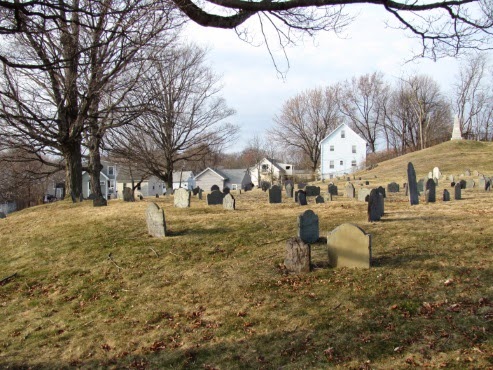This is a short biography of Samuel Richardson of Woburn, Massachusetts Bay Colony -
my paternal 8th Great-Grandfather
Samuel Richardson
(1646-1712)
He remarried to Hannah
Kingsley the following year and early in April 1676 she gave birth to
a healthy daughter. One week later, on 10 April 1676, while Hannah
nursed the newborn in bed, Samuel had his six-year-old son Samuel
with him, carting manure to the fields. Suddenly they heard screams
coming from the house, and saw feathers flying from the terrified
fowl in the front yard. Samuel raced back with his boy to find his
wife slaughtered in the bed. Their nurse who had been helping the new
mother in her recovery from the recent birth had tried to save the
infant, but had dropped her outside in her haste to get away. The
pursuing Indians had dashed the baby's brains out. Dead too was
little Samuel's twin brother Thomas, age 6.
 |
| First Burying Ground, Woburn, MA (wikipedia) |
Samuel Richardson and a group
of his neighbors went out to find the Indians who had massacred his
family. They came upon a group of three Indians and there was a
skirmish in which one of the Indians was killed and the other two
fled.
This horror took place against
the backdrop of the King Philip's war, which had begun in June of
1675 and would continue until late summer of 1676. During this armed
conflict between the local Native Americans and the English, in which our Samuel served, many
colonists were attacked in such a manner and even whole villages
were wiped out, the English inhabitants slaughtered or driven away. A
dozen villages across Massachusetts and Rhode Island were thus
eliminated before the killing ended after “King Philip”, or
Metacomet, the leader of the Indian faction, was killed in August
1676. However, the war continued with ongoing raids occurring, mostly
in what is now Maine, until a treaty was signed in April of 1678.
The grievances of the Native
American populations included the expansion of the English population
along with the taking of more and more land. In addition, the Native
American people had been ravaged by diseases brought by the English
to which the Indians had no immunity. Finally, break-downs in
diplomatic relations between the Indians and English, often having to
do with alliances with rival tribes, contributed to the boiling over
of the Native Americans' frustrations which led to attacks on the
English and war.
The King Philip's war is
considered by many historians to be the deadliest war in American
history. In the short space of sixteen months, twelve towns were
obliterated, and over half of all New England towns were attacked,
sending the colonial economy into a tailspin. The English population
was decimated. Nearly a tenth of all military service aged men were
lost.
The best book and reference that I have so far read about this tragic series of events in American history is Flintlock and Tomahawk: New England in King Philip's War by Douglas Edward Leach.
Samuel Richardson survived this sad episode in history and remarried two more times, fathering a total of fifteen children.
The best book and reference that I have so far read about this tragic series of events in American history is Flintlock and Tomahawk: New England in King Philip's War by Douglas Edward Leach.
Samuel Richardson survived this sad episode in history and remarried two more times, fathering a total of fifteen children.



No comments:
Post a Comment